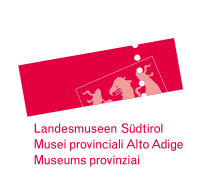Knights’ Hall
Status and power. This is where the Counts of Tyrol received their guests, administered justice, celebrated feasts and took their meals. The museum concept is that there are no installations in the Knights’ Hall so that it can be used for concerts and events. If you look out from the podium through the large triple-arched window into the landscape below, you will have a breath-taking view over the Adige Valley and the heartlands of the County of Tyrol. The famous topographer Beda Weber described this view in 1838 as follows: “The windows open up to the luminous vista of the broad Adige Valley, nature’s own giant colosseum, where Castle Tyrol took pride of place on the most favourable spot, like a tiny lodge […]”.
Capital, dragon. The rich sculptural designs on the capitals of the pillars in the Knights’ Hall along with the two marble portals are ranked amongst the major works of Romanesque stonemasonry in Tyrol. They take their format from Lombard traditions. There is an iconographic programme to the carvings on the capitals which convey a deeper meaning, and the room itself becomes the mare saeculi, the “sea of the world”, which threatens to shipwreck even a virtuous life.


